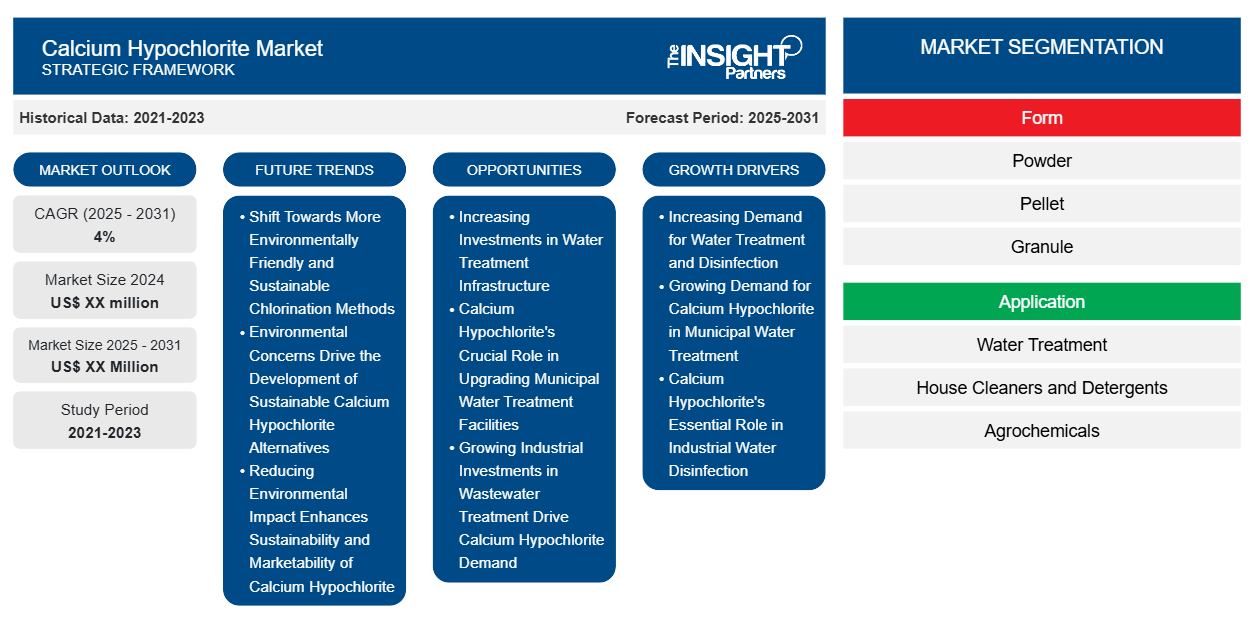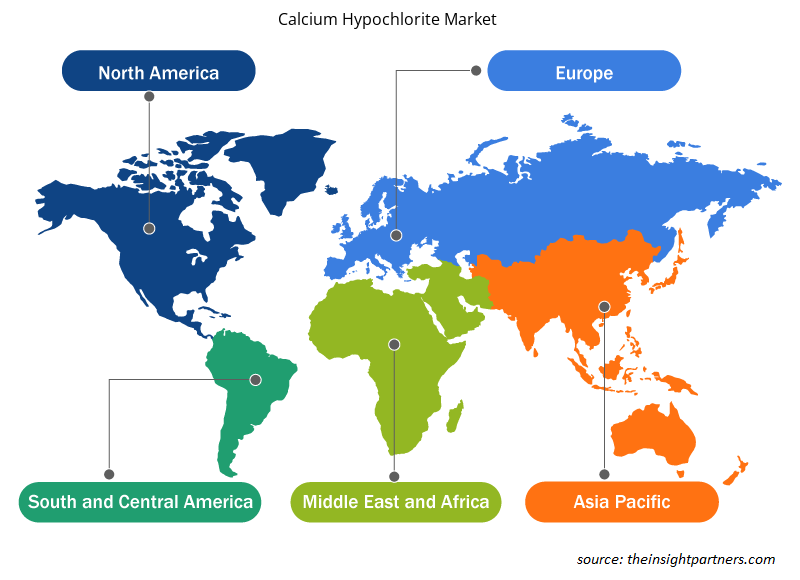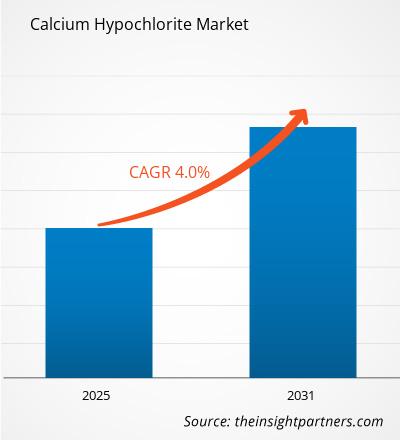次氯酸钙市场规模预计将从2024年的6.1514亿美元增至2031年的8.7489亿美元。预计2025年至2031年期间,该市场的复合年增长率将达到5.4%。在预测期内,对可持续解决方案的日益关注可能会为市场带来新的趋势。
次氯酸钙市场分析
人们对营造更健康、更卫生的环境的日益关注,导致工业部门对洗涤剂和清洁剂的需求不断增长,从而推动了次氯酸钙市场的发展。此外,互联网和移动设备的普及率不断提高,越来越多的人可以访问网店。这为寻求更广泛客户群的公司开辟了一个巨大的潜在市场。随着电子商务行业的蓬勃发展,包括包装材料、卫生用品和印刷纸在内的纸制品消费量正在增加。预计这将推动对次氯酸钙的需求,因为它被广泛用于将纸浆漂白到所需的白度和质量。
次氯酸钙市场概况
全球次氯酸钙市场正经历显著增长,这得益于其在各行各业的广泛应用。次氯酸钙,俗称漂白粉,分子式为Ca(ClO)2。它是一种无机化合物,由氢氧化钙与氯气反应生成。次氯酸钙广泛应用于水处理、纸浆和造纸、洗涤剂和农用化学品等领域。在水处理应用中,次氯酸钙可用于消毒、去除异味和有机物以及脱色。
随着人们对水和废水处理活动的日益关注,以及洗涤剂和清洁剂应用对次氯酸钙需求的不断增长,推动了市场扩张。此外,对可持续解决方案的日益重视也推动了次氯酸钙的使用。
定制此报告以满足您的要求
您可以免费定制任何报告,包括本报告的部分内容、国家级分析、Excel 数据包,以及为初创企业和大学提供优惠和折扣
次氯酸钙市场:战略洞察

-
获取此报告的顶级关键市场趋势。此免费样品将包括数据分析,从市场趋势到估计和预测。
次氯酸钙市场驱动因素和机遇
洗涤剂和清洁剂应用对次氯酸钙的需求不断增加
次氯酸钙在各种工业环境中应用广泛。它也是家用清洁产品的原材料之一,用于洗涤剂、肥皂、油脂或污渍去除剂、药物清洁剂以及其他医疗器械。次氯酸钙也广泛用于家用设备清洁。随着城市化和现代化的快速发展,人们越来越重视保持清洁卫生的生活环境。这种日益增强的卫生清洁意识在城市地区尤为明显,因为城市人口密度高,共享生活空间也加剧了细菌和病原体传播的风险。因此,消费者越来越重视有效的清洁习惯,包括定期使用清洁剂,以保护自己和家人免受疾病和感染。此外,新冠疫情提高了全世界对卫生清洁的认识。这场疫情强调了在住宅、商业和工业场所保持良好卫生习惯的重要性。食品加工、酒店和制造业都需要有效的卫生清洁措施。
新兴国家电子商务的兴起
电子商务的兴起,尤其是在新冠疫情之后,对全球零售业产生了巨大的影响。互联网改变了消费者的行为,尤其是人们的购物方式。截至目前,全球 80 亿人口中有 64% 使用互联网,这一数字在过去十年中翻了一番。近年来,新兴市场的电子商务行业经历了惊人的增长。这些市场包括非洲、拉丁美洲、亚洲和中东的国家,为寻求全球扩张的公司提供了重大机遇。庞大的在线消费者群体、不断增长的智能手机普及率、经济增长、不断壮大的中产阶级以及对国际产品的需求,正在推动新兴市场电子商务行业的发展。收入的增加和消费习惯的改变促使中产阶级人口转向网上购物。这一群体重视多样性、便利性和可及性,因此电子商务平台是他们首选的购物目的地。
次氯酸钙市场报告细分分析
有助于得出次氯酸钙市场分析的关键部分是形式和应用。
- 按形态划分,次氯酸钙市场分为粉末和颗粒。2024年,粉末市场占据了更大的市场份额。
- 按应用领域划分,市场主要分为水处理、家用清洁剂和洗涤剂、农用化学品、纸浆和造纸、食品和饮料等。2024年,水处理领域占据了最大的市场份额。
次氯酸钙市场份额地域分析
次氯酸钙市场报告的地理范围分为五个区域:北美、亚太、欧洲、中东和非洲以及南美和中美。预计北美次氯酸钙市场在预测期内将大幅增长。
由于纸张和纸浆的生产和需求不断增长,以及水处理项目不断增多,北美次氯酸钙市场正在经历显著增长。据美国国家空气和溪流改善委员会称,由于森林资源丰富,该地区拥有 450 多家造纸厂和纸浆厂。在美国,林产品市场占制造业 GDP 的 4% 以上,而在加拿大,林产品市场占该国制造业 GDP 的 12%。次氯酸钙是一种经济有效的漂白纸浆的方法,可达到纸张和纸浆生产所需的白度。该地区的几个水处理项目促进了次氯酸钙市场的增长。次氯酸钙广泛用于废水处理项目,因为它溶解在水中时对于消除病毒、细菌和其他病原体至关重要。Whites Creek 废水处理厂是该地区一个重要的水处理项目,由 Metro Water Services 于 2024 年承建。预计将于 2029 年完工,耗资超过 4.03 亿美元。因此,水和废水处理以及纸浆和造纸等终端使用行业的不断增长推动了该地区对次氯酸钙的需求。由于政府的有利举措,亚太地区主要国家(例如中国和印度)正经历显著增长。中国政府在水质和环境保护方面实施的严格规定进一步推动了次氯酸钙基溶液的采用。例如,根据国际贸易管理局的数据,中国政府已设定目标,使所有县级城市废水处理率达到 95%。此外,据国务院新闻办公室称,2024 年,中国将启动 47,000 个节水项目,总投资额为 1,850 亿美元。该国水处理项目数量的增加将推动对用于水消毒的次氯酸钙的需求。由于印度纺织业的不断发展,印度的次氯酸钙市场正在快速增长。根据印度新闻信息局的数据,纺织业贡献了印度GDP的约2%,出口总额的8.21%,以及工业产值的10%。据同一来源称,印度是第六大纺织品出口国,占全球纺织品出口的3.91%。次氯酸钙在纺织行业中被广泛用于服装洗涤厂,作为一种经济高效的脱色和整理化学品。因此,纺织业的蓬勃发展刺激了印度对次氯酸钙的需求。
次氯酸钙市场区域洞察
Insight Partners 的分析师已详尽阐述了预测期内影响次氯酸钙市场的区域趋势和因素。本节还讨论了北美、欧洲、亚太地区、中东和非洲以及南美和中美洲的次氯酸钙市场细分和地域分布。

- 获取次氯酸钙市场的区域具体数据
次氯酸钙市场报告范围
| 报告属性 | 细节 |
|---|---|
| 2024年的市场规模 | 6.1514亿美元 |
| 2031年的市场规模 | 8.7489亿美元 |
| 全球复合年增长率(2025-2031) | 5.4% |
| 史料 | 2021-2023 |
| 预测期 | 2025-2031 |
| 涵盖的领域 |
按形式
|
| 覆盖地区和国家 |
北美
|
| 市场领导者和主要公司简介 |
|
次氯酸钙市场参与者密度:了解其对业务动态的影响
次氯酸钙市场正在快速增长,这得益于终端用户需求的不断增长,而这些需求的驱动因素包括消费者偏好的转变、技术进步以及对产品优势的认知度的提升。随着需求的增长,企业正在扩展产品线,不断创新以满足消费者需求,并抓住新兴趋势,从而进一步推动市场增长。
市场参与者密度是指特定市场或行业内企业或公司的分布情况。它表明特定市场空间内竞争对手(市场参与者)的数量相对于其规模或总市值而言。
在次氯酸钙市场运营的主要公司有:
- 美国元素公司
- Aditya Birla Chemicals(泰国)有限公司
- Innova公司
- 日本曹达株式会社
- 天津瑞福鑫化工有限公司
- 西湖化学公司
免责声明:以上列出的公司没有按照任何特定顺序排列。

- 获取次氯酸钙市场主要参与者概览
次氯酸钙市场新闻及最新动态
次氯酸钙市场评估通过收集一手资料和二手资料进行定性和定量分析,包括重要的企业出版物、协会数据和数据库。次氯酸钙市场的一些关键发展如下:
- INEOS Inovyn 推出了全新超低碳系列 (ULC) 氯碱产品,与行业平均水平相比,可将烧碱、烧钾和氯的碳足迹减少高达 70%。该系列产品采用可再生能源为 INEOS Inovyn 的生产基地提供动力。首批生产基地包括挪威的 Rafnes(使用当地水力发电)和比利时的安特卫普(直接使用北海风力涡轮机的电力)。(来源:INEOS,新闻稿,2024 年 2 月)
- 领先的化工公司 Bondalti 宣布,其位于巴塞罗那的子公司 Bondalti IBERICA 将对西班牙最大的氯碱和聚氯乙烯 (PVC) 生产商 Ercros 100% 的股份发起公开收购要约。(来源:Bondalti,新闻稿,2024 年 3 月)
次氯酸钙市场报告覆盖范围和交付成果
《次氯酸钙市场规模和预测(2021-2031)》报告对以下领域进行了详细的市场分析:
- 次氯酸钙市场规模以及本范围涵盖的所有主要细分市场的全球、区域和国家层面的预测
- 次氯酸钙市场趋势以及市场动态,例如驱动因素、限制因素和关键机遇
- 详细的波特五力模型和 SWOT 分析
- 次氯酸钙市场分析涵盖主要市场趋势、全球和区域框架、主要参与者、法规和最新市场发展
- 行业格局和竞争分析,包括市场集中度、热图分析、知名参与者以及次氯酸钙市场的最新发展
- 详细的公司简介
- 历史分析(2 年)、基准年、预测(7 年)及复合年增长率
- PEST和SWOT分析
- 市场规模、价值/数量 - 全球、区域、国家
- 行业和竞争格局
- Excel 数据集
近期报告
客户评价
购买理由
- 明智的决策
- 了解市场动态
- 竞争分析
- 客户洞察
- 市场预测
- 风险规避
- 战略规划
- 投资论证
- 识别新兴市场
- 优化营销策略
- 提升运营效率
- 顺应监管趋势






















 获取免费样品 - 次氯酸钙市场
获取免费样品 - 次氯酸钙市场